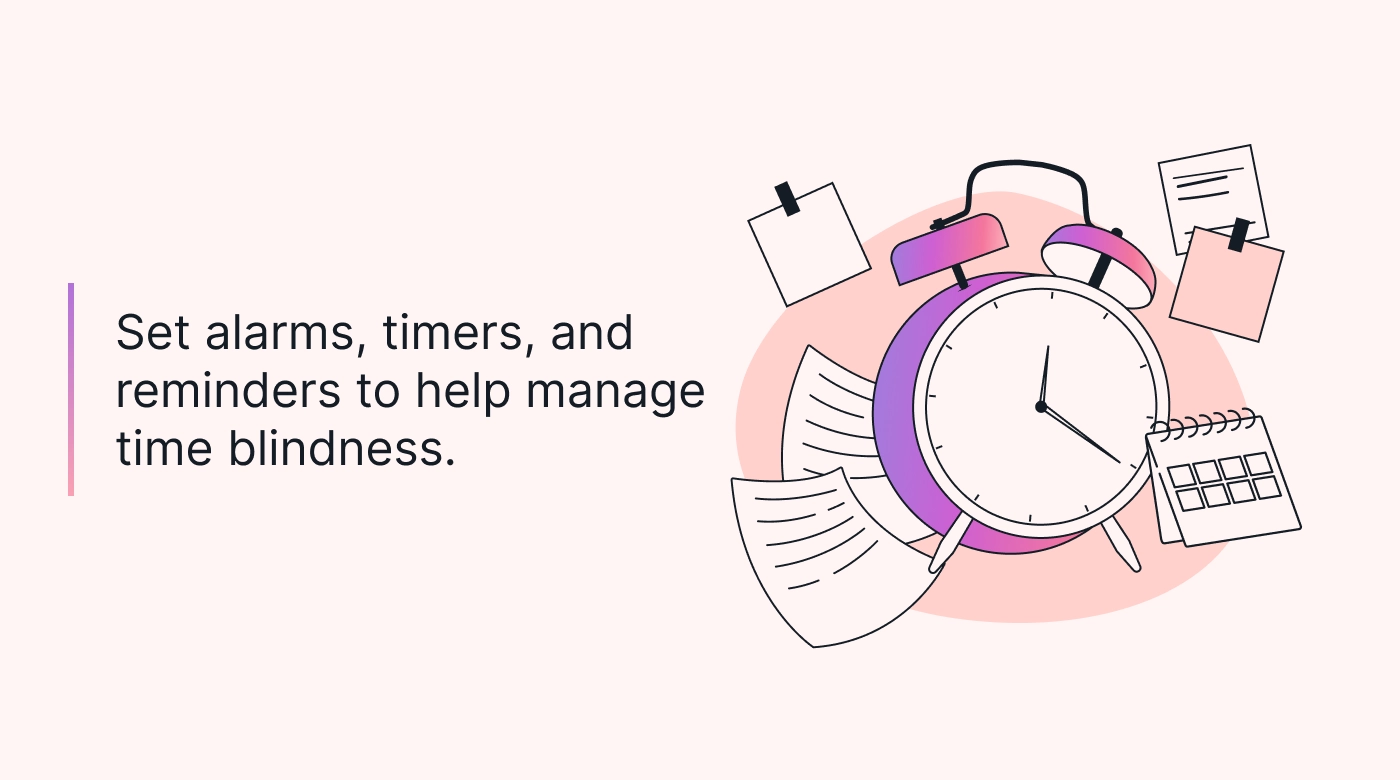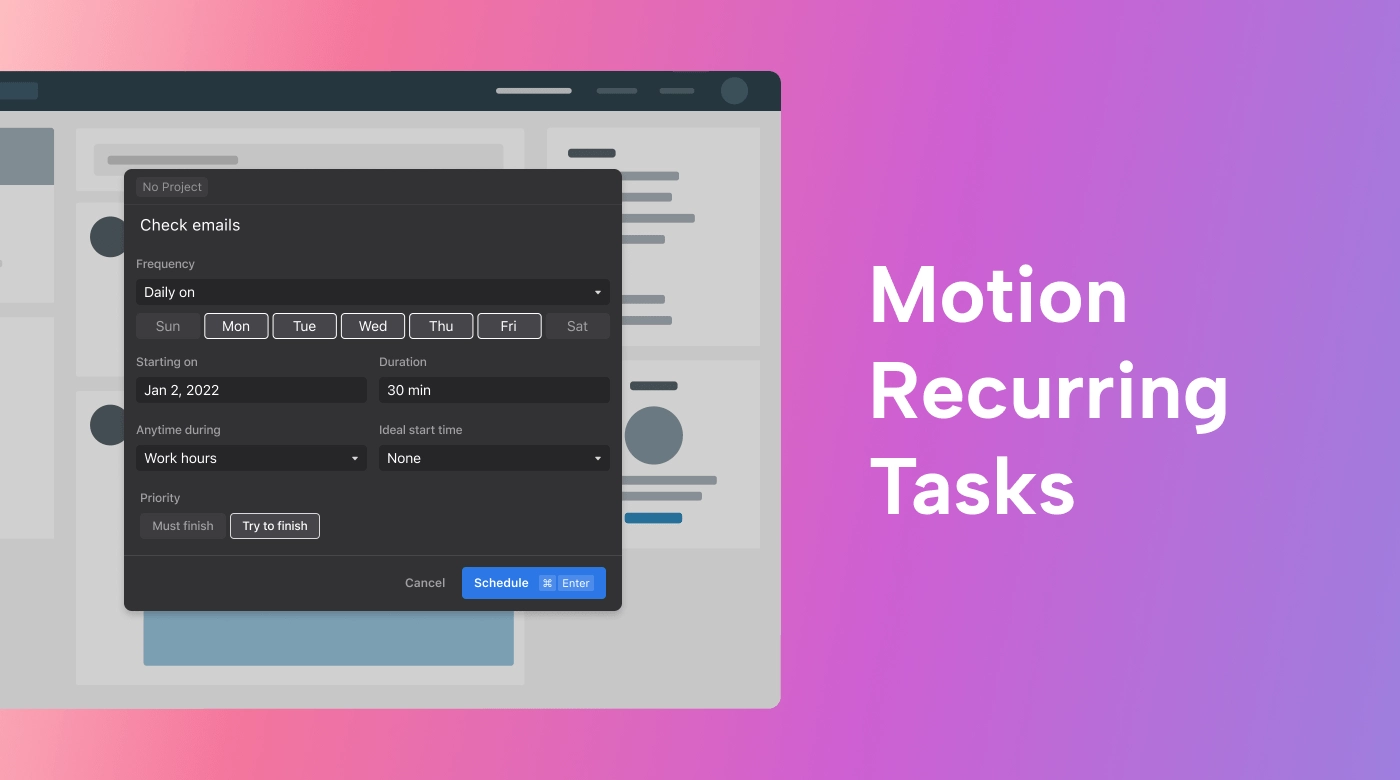Oh no. Not again.
Your heart sinks, and you bury your face in your hands as you realize you have to tell your team you’ve blown an important deadline. Again.
Your problem has a name: time blindness. And the good news is it’s 100% fixable.
If you’re wondering how time always seems to slip away from you — and how you can get it back — read on. This article addresses the causes and common symptoms of time blindness. We also look at key strategies you can implement to manage your internal clock more effectively and take back your workday.
What is time blindness?
In general, time blindness refers to a person’s struggles with understanding and managing time. It is not an official diagnosis or medical condition. While it is often associated with Attention Deficit Hyperactivity Disorder (ADHD), it can happen to anyone.
Time blindness has two components: a lack of awareness of how much time has passed and an inability to assess how much time is needed to accomplish a task.
Have you noticed how time flies when you’re doing an activity you love?
We often see time blindness occur when we’re wrapped up in something we enjoy. Here, we shift into hyperfocus mode — our attention is entirely caught up in our actions.
The opposite is often true, too — time seems to stand still when we’re completing mundane, repetitive tasks.
So, why is this the case? Let’s take a look.
What causes time blindness?
Time blindness is linked to your brain chemistry.
When you’re engaged in something you enjoy doing, your brain shifts into automatic attention mode or “autopilot.” Maintaining this type of attention is effortless, so your brain is content to let you continue in the activity for as long as you’d like (and ignore the passing of time as a result).
Time blindness is also related to low dopamine levels.
 |
Dopamine leads to feelings of enjoyment, contentment, and motivation. Participating in an activity you enjoy releases it, meaning you’re more likely to continue the activity — and lose track of time as a result.
This powerful neurotransmitter also affects our ability to focus, learn, and remember. If your dopamine levels are low, you’ll find it harder to concentrate on your work and complete your tasks efficiently.
While time blindness can also occur with diagnoses such as ADHD and autism, it’s crucial to remember it can happen to anyone.
What are the symptoms of time blindness?
Certain signs and symptoms characterize people with time blindness.
 |
People with it often:
- Are chronically late to appointments, meetings, and get-togethers.
- Consistently miss deadlines, appointments, and other commitments altogether.
- Procrastinate and put off work, everyday tasks, or obligations until the last minute.
- Misjudge the amount of time needed to complete an activity, either by devoting too much time to a project or not allocating enough time in the first place.
- Have difficulty with organization, whether that’s planning ahead, making appointments, forming a schedule, or completing a project that has multiple steps.
- Struggle to complete tasks without being distracted or take too long to finish projects due to multiple stops and starts.
- Tend to get stuck on specific activities, especially projects of high value and enjoyment, and ignore necessary transitions as a result.
- Find it impossible to recall how long ago an activity occurred or how much time it took to complete it.
- Feel guilt, frustration, and a sense of letting others down.
While the symptoms of time blindness may leave you feeling defeated, it doesn’t have to stay that way. People with time blindness can manage their symptoms with the strategies below.
Strategies to help manage time blindness
Successfully manage time blindness with the following tips:
Be mindful
Start by improving your sense of time, including how long it takes to complete a task, run an errand, or make a transition.
To do this, select a few tasks you complete regularly. Set a stopwatch as soon as you start a task, then check how much time elapsed once you’ve finished. Or set a timer for 15 minutes. Then, when the buzzer sounds, see how far you’ve gotten with your assignment.
Take notes and refer back to them when planning your day to get a sense of how much time you’ll need.
Make this even easier with Motion’s time-tracking feature. Once a task is started, Motion will calculate how long it takes until it’s completed. That way, you’ll be better prepared for the next time the same type of task rolls around.
You can also increase your awareness of time by identifying the areas where you get distracted and need more time than you initially think. For example, do you check your email notifications each time you’re supposed to be working on a quarterly report? If that’s the case, turn off your notifications or set up banners through Motion to remind you to stay on task.
You’ll also want to get a handle on the activities that cause you to lose track of time. What are those things you love doing and could spend all day on (but really shouldn’t)?
Narrow down the items and tasks you tend to put off, too. Techniques for overcoming procrastination, such as breaking down large projects into smaller steps, can increase your odds of success.
Activate reminders
While being mindful about time is important, don’t be afraid to take advantage of the resources available to support time management.
 |
While you may already set alarms to notify you of upcoming meetings or appointments, try setting more than one. You may miss the first, but it gets harder to ignore the second or third time you hear it ring.
Assign different tones to each item on your list, too. For example, use a simple alarm for a work project and your partner’s favorite song to remind you to meet them for dinner. And every few months, change the tones to ensure the brain doesn’t habituate or start to tune out what it hears.
Set visual timers, countdowns, and schedule reminders in your calendar to keep you mindful of upcoming items.
Use different formats — laptops, phones, smartwatches, or physical devices — for reminders. If the task is mission-critical, turn to a trusted friend or colleague to call or text you when the time comes.
With Motion’s Task Manager, you can set each task’s priority, deadline, and anticipated completion date. You’ll see at a glance which tasks are completed and which are coming up.
Implement time management techniques
Now that you’ve estimated time and collected reminder strategies, you’re ready to put them into practice with proven time management techniques.
- To-do lists and daily planners are a must to keep you on top of your daily workload. Once you’ve scheduled your meetings and appointments, you can auto-schedule other tasks to save valuable time.
- Set SMART goals: goals that are specific, measurable, achievable, relevant, and time-bound.
- The Pomodoro Technique is a series of structured work blocks where you commit to 25 minutes of work, followed by a 5-minute break. Somehow, daunting tasks feel a little easier if you’re only at them for under half an hour.
- Effective time blocking helps you guard your deep work time. You identify which areas need intensive focus, then slot them in with a time blocking template (just don’t forget to set the alarm).
- Prioritize your most important tasks and events of the day.
 |
With Motion, you can easily prioritize your week’s most important tasks. The Task Manager feature automatically slots your tasks based on their priority and builds them into your schedule accordingly.
Fuel your brain
Did you know that certain activities, foods, and drinks can help you combat time blindness?
Kick off your day with a low-dopamine morning routine. With this routine, you start with activities that bring calm and focus to your morning.
For example, you might meditate, journal, or head outside for a short stroll. These activities, while enjoyable, don’t trigger those rushes of dopamine that leave you craving even more satisfaction or feel-good boosts throughout the rest of the day.
Commit to consistent exercise habits, too. The positive effects of dopamine release from exercise can continue for a week or so after.
Natural sunlight exposure, listening to music, and engaging in your favorite hobbies also boost dopamine levels.
Coffee is a well-known stimulant that can raise your energy level. But if you love that morning fix, hold off until you’ve gone through your calming, low-dopamine routine.
 |
Stock your shopping cart with foods rich in vitamin B6, such as fish, chickpeas, oranges, and dark leafy greens. Additional dopamine boosters include iron-rich foods, such as chicken, lentils, and eggs, as well as folate-rich peanuts, whole grains, and fresh fruit.
Recalibrate your focus time
You may be surprised to learn that “focus time” has two meanings.
It’s commonly referred to as the uninterrupted blocks you schedule for your deep work time. Using computer-protected focus time, such as turning off notifications, positively affects employee engagement and productivity.
This focus time should be a priority. Take the heavy lifting off your plate and let Motion’s Intelligent Calendar guard your time blocks.
The lesser-known meaning of focus time is its reference to the start time of an activity. For example, if a meeting starts at 2:00 pm, your focus is to attend the meeting then. If you struggle with time blindness, 2:00 has come and gone before you know it, and you’re slinking into the meeting at 2:20.
Adjust your focus time to get you back on track. Reset your 2:00 meeting in your calendar (and your mind) to a 1:45 meeting to give you extra time. Recalibrating the start time positions you to start transitioning when you need to — and get there on time.
Give yourself a break
Managing time blindness may not be easy, but you don’t have to go it alone.
Reach out to trusted colleagues and managers for support. Let them know you struggle to keep track of time and the techniques you’re using. Listen to their feedback and make adjustments.
You also need to think about the quality of your daily life and well-being outside of the workplace. About 52% of employees report having higher stress levels now than ever before. Take steps to manage your stress, including setting clear boundaries between your work and home lives.
Take regular breaks to help you maintain focus inside and outside your structured work tasks.
 |
Your brain needs breaks from activities that require high concentration, so put a recurring task on your calendar to take a walk, drink water, or listen to your favorite music.
With these strategies in place, you’ll be better positioned to combat time blindness and regain control of each day.
Take back your time with Motion
Ready to take back your workdays?
Manage time blindness by understanding when and how you seem to lose track of time. Plus, set consistent reminders, eat nutritious foods, and use effective tools and time management techniques to help you.
If you want to simplify and streamline your schedule and tasks, turn to Motion.
The Task Manager helps you meet deadlines by planning, organizing, and prioritizing your tasks. Add new items when needed and set recurring daily and weekly must-do tasks. Motion will even pop a banner on your screen when necessary to keep you focused on your current activity.
Don’t wait to start managing your time more effectively. Start your risk-free 7-day trial with Motion today.

Jodi Monroe is a content writer and blogger in the SaaS space. When not at her laptop, she’s planning her next travel adventure.




